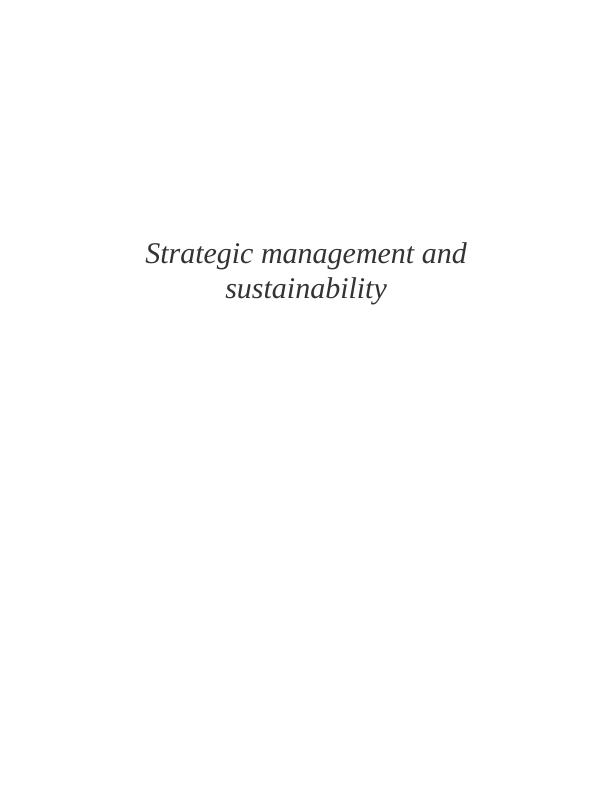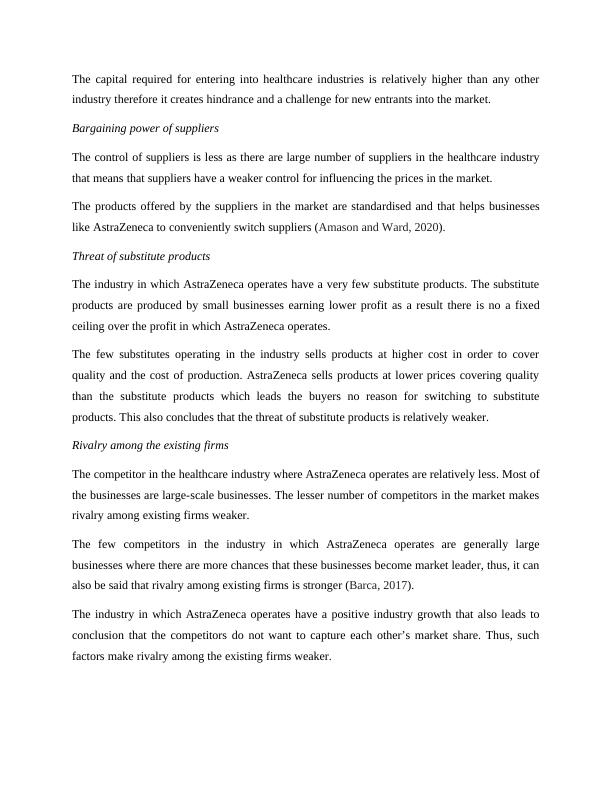Strategic Management and Sustainability in the Pharmaceutical Industry: A Case Study of AstraZeneca
Added on 2023-06-18
13 Pages3024 Words239 Views
Strategic management and
sustainability
sustainability

Table of Contents
INTRODUCTION...........................................................................................................................3
MAIN BODY..................................................................................................................................3
Determine with evidence the UK and the global pharmaceutical industry. Use related
frameworks to analyse industry and sector critically..................................................................3
Determine with evidence the competitive environment of AstraZeneca.....................................9
CONCLUSION..............................................................................................................................10
REFERENCES..............................................................................................................................12
INTRODUCTION...........................................................................................................................3
MAIN BODY..................................................................................................................................3
Determine with evidence the UK and the global pharmaceutical industry. Use related
frameworks to analyse industry and sector critically..................................................................3
Determine with evidence the competitive environment of AstraZeneca.....................................9
CONCLUSION..............................................................................................................................10
REFERENCES..............................................................................................................................12

INTRODUCTION
It becomes important to analyse the business environment in order to evaluate the impact
of different external macro factors on business performance and decision making. There are
certain environment analysis tools that not only determines the impact of such factors but also
supports to define the competition and the strategies that a business needs to implement
pertaining to different situational context. AstraZeneca is a British global pharmaceutical
company which headquartered in England, UK. It is a public limited company founded in the
year 1999. AstraZeneca sells pharmaceutical products for major diseases such as infection,
neuroscience, respiratory, inflammation and others. It is also a famous pharmaceutical brand
known for making Oxford AstraZeneca COVID-19 vaccine. This report talks about the industry
and sector analysis in the context of AstraZeneca and evaluation of competitive environment
supported with the theories, models and relevant sources (Alyoubi, 2015).
MAIN BODY
Determine with evidence the UK and the global pharmaceutical industry. Use related
frameworks to analyse industry and sector critically.
Industry five forces analysis
Industry five forces analysis conducted on the healthcare industry in which AstraZeneca plc
operates.
Threat of new entrants
(Porter’s Five Forces Analysis. 2021) Economies of scale is challenging to accomplish in the
industry where the AstraZeneca plc operates which makes huge cost for new entrants in the
healthcare industry and large businesses like AstraZeneca plc enjoys producing production at
large rate and attains economies of scale in the production function.
In Healthcare industry product different is strong where businesses sell differentiated products
that attracts the customers to purchase. Businesses in healthcare industry looks over strong
advertisement and customer services. Thus, such factors make challenging for new businesses in
the healthcare industry.
It becomes important to analyse the business environment in order to evaluate the impact
of different external macro factors on business performance and decision making. There are
certain environment analysis tools that not only determines the impact of such factors but also
supports to define the competition and the strategies that a business needs to implement
pertaining to different situational context. AstraZeneca is a British global pharmaceutical
company which headquartered in England, UK. It is a public limited company founded in the
year 1999. AstraZeneca sells pharmaceutical products for major diseases such as infection,
neuroscience, respiratory, inflammation and others. It is also a famous pharmaceutical brand
known for making Oxford AstraZeneca COVID-19 vaccine. This report talks about the industry
and sector analysis in the context of AstraZeneca and evaluation of competitive environment
supported with the theories, models and relevant sources (Alyoubi, 2015).
MAIN BODY
Determine with evidence the UK and the global pharmaceutical industry. Use related
frameworks to analyse industry and sector critically.
Industry five forces analysis
Industry five forces analysis conducted on the healthcare industry in which AstraZeneca plc
operates.
Threat of new entrants
(Porter’s Five Forces Analysis. 2021) Economies of scale is challenging to accomplish in the
industry where the AstraZeneca plc operates which makes huge cost for new entrants in the
healthcare industry and large businesses like AstraZeneca plc enjoys producing production at
large rate and attains economies of scale in the production function.
In Healthcare industry product different is strong where businesses sell differentiated products
that attracts the customers to purchase. Businesses in healthcare industry looks over strong
advertisement and customer services. Thus, such factors make challenging for new businesses in
the healthcare industry.

The capital required for entering into healthcare industries is relatively higher than any other
industry therefore it creates hindrance and a challenge for new entrants into the market.
Bargaining power of suppliers
The control of suppliers is less as there are large number of suppliers in the healthcare industry
that means that suppliers have a weaker control for influencing the prices in the market.
The products offered by the suppliers in the market are standardised and that helps businesses
like AstraZeneca to conveniently switch suppliers (Amason and Ward, 2020).
Threat of substitute products
The industry in which AstraZeneca operates have a very few substitute products. The substitute
products are produced by small businesses earning lower profit as a result there is no a fixed
ceiling over the profit in which AstraZeneca operates.
The few substitutes operating in the industry sells products at higher cost in order to cover
quality and the cost of production. AstraZeneca sells products at lower prices covering quality
than the substitute products which leads the buyers no reason for switching to substitute
products. This also concludes that the threat of substitute products is relatively weaker.
Rivalry among the existing firms
The competitor in the healthcare industry where AstraZeneca operates are relatively less. Most of
the businesses are large-scale businesses. The lesser number of competitors in the market makes
rivalry among existing firms weaker.
The few competitors in the industry in which AstraZeneca operates are generally large
businesses where there are more chances that these businesses become market leader, thus, it can
also be said that rivalry among existing firms is stronger (Barca, 2017).
The industry in which AstraZeneca operates have a positive industry growth that also leads to
conclusion that the competitors do not want to capture each other’s market share. Thus, such
factors make rivalry among the existing firms weaker.
industry therefore it creates hindrance and a challenge for new entrants into the market.
Bargaining power of suppliers
The control of suppliers is less as there are large number of suppliers in the healthcare industry
that means that suppliers have a weaker control for influencing the prices in the market.
The products offered by the suppliers in the market are standardised and that helps businesses
like AstraZeneca to conveniently switch suppliers (Amason and Ward, 2020).
Threat of substitute products
The industry in which AstraZeneca operates have a very few substitute products. The substitute
products are produced by small businesses earning lower profit as a result there is no a fixed
ceiling over the profit in which AstraZeneca operates.
The few substitutes operating in the industry sells products at higher cost in order to cover
quality and the cost of production. AstraZeneca sells products at lower prices covering quality
than the substitute products which leads the buyers no reason for switching to substitute
products. This also concludes that the threat of substitute products is relatively weaker.
Rivalry among the existing firms
The competitor in the healthcare industry where AstraZeneca operates are relatively less. Most of
the businesses are large-scale businesses. The lesser number of competitors in the market makes
rivalry among existing firms weaker.
The few competitors in the industry in which AstraZeneca operates are generally large
businesses where there are more chances that these businesses become market leader, thus, it can
also be said that rivalry among existing firms is stronger (Barca, 2017).
The industry in which AstraZeneca operates have a positive industry growth that also leads to
conclusion that the competitors do not want to capture each other’s market share. Thus, such
factors make rivalry among the existing firms weaker.

End of preview
Want to access all the pages? Upload your documents or become a member.
Related Documents
Strategic Analysis Reportlg...
|16
|3993
|225
Strategic Management and Sustainability in the Pharmaceutical Industry: A Critical Analysis of AstraZenecalg...
|11
|3333
|184
Strategic Marketinglg...
|16
|1049
|364
Strategic Management and Sustainability in Pharmaceutical Industrylg...
|12
|3217
|197
Strategic Management and Sustainabilitylg...
|11
|3495
|222
Business Environment Analysis: PDFlg...
|11
|3523
|333